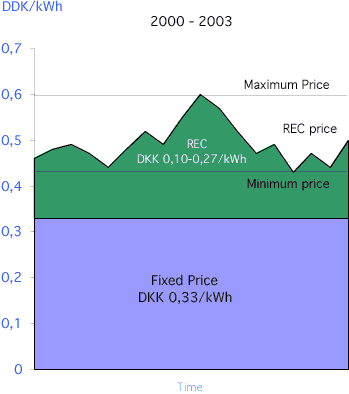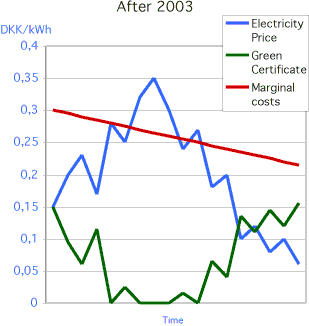Green
Certificates in Denmark:
The
Litmus Test
Christian Kjaer,
Danish Wind Turbine Manufacturers Association
January 2001
Denmark was the birthplace of fixed tariff payments to encourage renewable energy investment. Now it is slowly moving towards a market-based system with tradable green certificates which is not proving an easy ride.
The year 2000 was another record-breaking period in the history
of Danish wind energy. At the latest count app. 600 MW of capacity
had been installed when the calendar flipped to 2001. But the
contracts which accompanied those wind turbines were all signed
before the end of 1999. Uncertainty about Denmark's new renewables
portfolio standard meant that, at the time of writing at least,
the millennium still had to produce its first Danish contract
for new wind capacity.
![]() The
political framework for a new Danish support system based on
a renewables portfolio standard (RPS) has in fact been in place
since March 1999. It succeeds the 15 year old system of fixed
tariffs, under which a standard payment was made for every kilowatt
hour of energy produced.
The
political framework for a new Danish support system based on
a renewables portfolio standard (RPS) has in fact been in place
since March 1999. It succeeds the 15 year old system of fixed
tariffs, under which a standard payment was made for every kilowatt
hour of energy produced.
![]() What
Denmark hopes to achieve with its new RPS-based system is a steady
decline in the cost of renewables through the introduction of
competition between suppliers of green electricity.
What
Denmark hopes to achieve with its new RPS-based system is a steady
decline in the cost of renewables through the introduction of
competition between suppliers of green electricity.
![]() The
new system places an obligation on all Danish electricity consumers,
requiring them to buy 20% of their electricity from renewable
energy sources by 2003. The RPS is also backed by a market for
green power credit trading under which producers are issued with
certificates for their output. They can then sell these to the
highest bidding electricity supplier. This market was supposed
to have been in place by 1 January 2000.
The
new system places an obligation on all Danish electricity consumers,
requiring them to buy 20% of their electricity from renewable
energy sources by 2003. The RPS is also backed by a market for
green power credit trading under which producers are issued with
certificates for their output. They can then sell these to the
highest bidding electricity supplier. This market was supposed
to have been in place by 1 January 2000.
Two
Year Delay
Creating a Danish market has proved a far more complicated
task than anybody dared to dream, however. The result has been
that it has had to be postponed for at least two years. The first
green certificate will not now be traded until 2002 at the earliest.
![]() Turbine
owners signing contracts for new installations between 1 January
2000 and 31 December 2002 will meanwhile receive two forms of
payment for the electricity they feed into the grid: a fixed
minimum price of DKK 0.33 plus a green certificate with a politically
dictated minimum value of DKK 0.10 and a maximum value of DKK
0.27 (see Figure 2).
Turbine
owners signing contracts for new installations between 1 January
2000 and 31 December 2002 will meanwhile receive two forms of
payment for the electricity they feed into the grid: a fixed
minimum price of DKK 0.33 plus a green certificate with a politically
dictated minimum value of DKK 0.10 and a maximum value of DKK
0.27 (see Figure 2).
![]() After
ten years of the turbine's operation, the system becomes fully
dependent on the market. Owners will receive the market price
for their electricity plus a green certificate whose value is
unlikely to be hedged by any price cap or lower limit.
After
ten years of the turbine's operation, the system becomes fully
dependent on the market. Owners will receive the market price
for their electricity plus a green certificate whose value is
unlikely to be hedged by any price cap or lower limit.
![]() Even
though the credit market is not in place yet, turbines that are
contracted after 1 January 2000 will still be eligible for green
certificates once trading commences. Danish buyers of wind turbines
therefore have to include green credits in their budgets. But
estimating a price for a green credit that does not yet exist,
and will not reach the market for at least the next year, is
no easy task.
Even
though the credit market is not in place yet, turbines that are
contracted after 1 January 2000 will still be eligible for green
certificates once trading commences. Danish buyers of wind turbines
therefore have to include green credits in their budgets. But
estimating a price for a green credit that does not yet exist,
and will not reach the market for at least the next year, is
no easy task.
![]() Equally
difficult is convincing people to invest in anything, be it stocks,
bonds or wind turbines, by promising a return on the investment
in the form of a currency in this case a certificate
that does not yet exist. That is why no contracts for new wind
turbines have been signed this year in Denmark. All the turbines
erected last year were contracted for before 1 January 2000,
and are thus entitled to the old fixed price tariff of DKK 0.60
(see Figure 1), for a transition
period of five to six years, before entering the certificates
market.
Equally
difficult is convincing people to invest in anything, be it stocks,
bonds or wind turbines, by promising a return on the investment
in the form of a currency in this case a certificate
that does not yet exist. That is why no contracts for new wind
turbines have been signed this year in Denmark. All the turbines
erected last year were contracted for before 1 January 2000,
and are thus entitled to the old fixed price tariff of DKK 0.60
(see Figure 1), for a transition
period of five to six years, before entering the certificates
market.
What
Price for Green Credits?
Wind power is supposed to satisfy up to three-quarters
of the Danish government's 20% renewable energy obligation by
2003. The remaining 5-6%, according to the Danish Energy Agency,
will mainly come from biomass. With an additional 400 MW of wind
power capacity coming on line during 2000, the 2003 target for
wind will be met two years in advance.
![]() Given
the inherent mechanics of the credit market, that should send
the price of a Danish green certificate towards the bottom of
the politically determined range of DKK 0.10 to 0.27.
Given
the inherent mechanics of the credit market, that should send
the price of a Danish green certificate towards the bottom of
the politically determined range of DKK 0.10 to 0.27.
![]() However,
because of the considerable uncertainties about the future certificates
market, Danish wind turbine owners are likely to demand a risk
premium in return for the lack of a properly functioning system.
That would send the price of green certificates banging against
the DKK 0.27 ceiling.
However,
because of the considerable uncertainties about the future certificates
market, Danish wind turbine owners are likely to demand a risk
premium in return for the lack of a properly functioning system.
That would send the price of green certificates banging against
the DKK 0.27 ceiling.
![]() Uncertainties
contributing to this upward pressure on certificate prices include
the lack of details about possible "banking" of certificates
and the introduction of financial instruments such as "futures"
and "options". These are complicated issues to deal
with for a private wind energy investor. Nevertheless, they are
crucial to the effectiveness of the certificate market.
Uncertainties
contributing to this upward pressure on certificate prices include
the lack of details about possible "banking" of certificates
and the introduction of financial instruments such as "futures"
and "options". These are complicated issues to deal
with for a private wind energy investor. Nevertheless, they are
crucial to the effectiveness of the certificate market.
Investment
on Hold
The complexity of the new support scheme, and the
worrying number of unanswered questions still outstanding, have
therefore together effectively put investors on hold until further
notice.
![]() When
the Danish market does start picking up again the industry may
find itself with a completely new customer base. The Danish Wind
Turbine Manufacturers Association predicts that the advanced
financial engineering tools which will be necessary for the market
to function will leave little room for the wind co-operatives
and individual owners who currently control approximately 80%
of Denmark's turbine capacity. Large transaction costs, economies
of scale for large investors and a lack of transparency for small
investors will gradually erode this local ownership, unless political
action prevents it.
When
the Danish market does start picking up again the industry may
find itself with a completely new customer base. The Danish Wind
Turbine Manufacturers Association predicts that the advanced
financial engineering tools which will be necessary for the market
to function will leave little room for the wind co-operatives
and individual owners who currently control approximately 80%
of Denmark's turbine capacity. Large transaction costs, economies
of scale for large investors and a lack of transparency for small
investors will gradually erode this local ownership, unless political
action prevents it.
![]() The
same scenario could well apply to investment in the 4,000 MW
of offshore projects which are expected to be built between now
and 2030 in order to reach the government's ambitious goal of
covering 50% of electricity consumption with wind power by 2030.
The
same scenario could well apply to investment in the 4,000 MW
of offshore projects which are expected to be built between now
and 2030 in order to reach the government's ambitious goal of
covering 50% of electricity consumption with wind power by 2030.
![]() Whilst
the Manufacturers Association is not opposed to the principle
of moving towards a market-oriented system, the way in which
it is being implemented in Denmark runs the risk, to use a classic
English phrase, of "throwing the baby out with the bath
water".
Whilst
the Manufacturers Association is not opposed to the principle
of moving towards a market-oriented system, the way in which
it is being implemented in Denmark runs the risk, to use a classic
English phrase, of "throwing the baby out with the bath
water".


